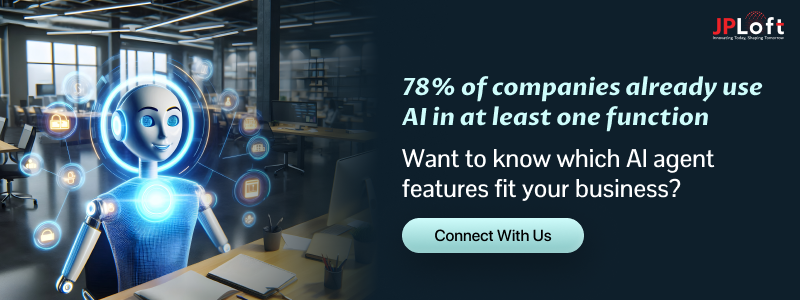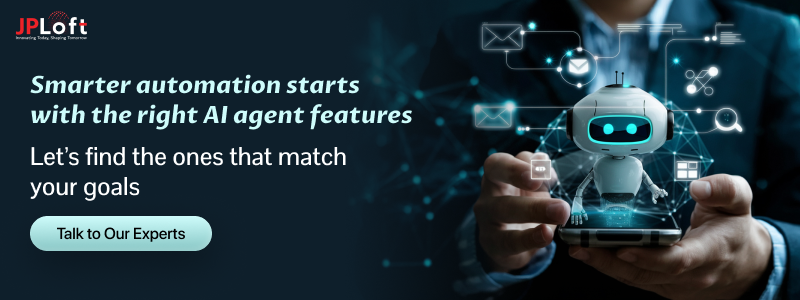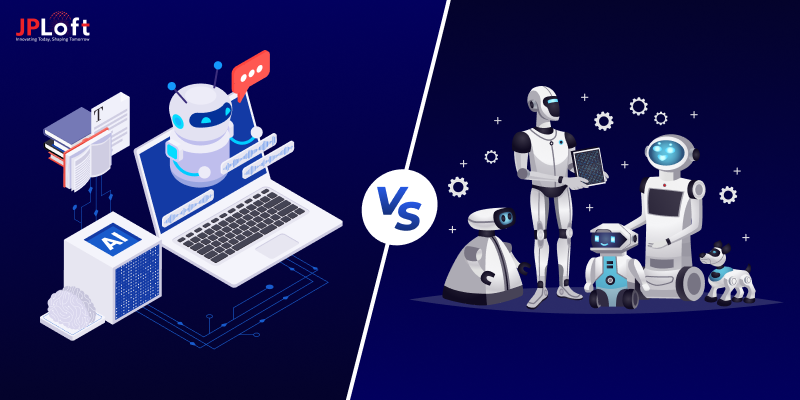“Any sufficiently advanced technology is indistinguishable from magic.” — Arthur C. Clarke
What this really means is that the wow factor only matters if it’s reliable. AI agents turn that “magic” into day-to-day value: they sense events, learn from patterns, and act without babysitting.
This statement highlights just how transformative AI is for every industry, much like electricity once was.
AI agents embody this transformation by acting as intelligent systems that sense, learn, and make decisions on their own.
But the real question is, what are the key AI agent features?
The answer lies in understanding both the basic and advanced AI agent features that power automation, personalization, and smarter decision-making.
From natural language understanding and adaptive behavior to predictive analysis and real-time optimization, each feature adds strength and versatility to your AI agent.
In this blog, we’ll explore the list of the best AI agent features in detail, showing how they can boost efficiency, enhance user experiences, and future-proof your business in the age of intelligent automation.
Let’s learn about the AI agent features below.
An Overview of AI Agents and Their Market
An AI agent is a computer program that can sense its environment, process information, and act autonomously to fulfill specific objectives. Unlike conventional apps, which just execute rigid instructions, AI agents learn from experience, evolve based on new information, and make decisions independently.
They can perform tasks such as answering questions, automating processes, data analysis, and even communicating with other systems. Briefly put, an AI agent is a computerized assistant that reasons and behaves smartly to make work easier and more efficient.
Now, let’s discover the market of AI agents, below.
-
The global AI agent market size was estimated at USD 5.40 billion in 2024 and is projected to reach USD 50.31 billion by 2030, growing at a CAGR of 45.8% from 2025 to 2030.
-
Additionally, the North America AI Agents market dominated with a revenue share of over 40.1% in 2024.
-
According to Markets and Markets, the AI Agent market size was valued at USD 5.25 billion in 2024 and is projected to grow from USD 7.84 billion in 2025 to USD 52.62 billion by 2030 at a CAGR of 46.3%.
-
The AI agent market size is worth USD 236.03 billion by 2034, fueled by machine learning and natural language processing advances
Looking forward to the growing AI agent market, are you ready to step in? Here, you are not only contributing to this diverse market but also enhancing the overall efficiency of your business.
Whether it's about building an AI agent for a website or an app, or integrating it with a programmable voice calling platform to manage voice tasks, you need to select suitable features Let’s explore more reasons to select the right features for your AI agent in the section below.
Why Include Suitable Features in Building an AI Agent?
If you have decided to convert an AI agent's ideas into reality, it's important to look for the key AI agent features that can help you convert the user’s buying behavior into increasing the retention rate for the business.
Let’s discover the reasons for selecting the best AI agent features here.
A] Improved User Experience
Carefully selected features, such as natural language comprehension and personalization, allow interactions to be smooth and intuitive. This makes users happy and more likely to come back.
Proper features ensure that the agent evolves based on user preferences, with the experience feeling closer to a human helper than a controlling program. Happy customers automatically translate to better retention and word-of-mouth expansion.
B] Increased Efficiency and Automation
Functions like task ordering and workflow automation minimize human effort. This allows teams to concentrate on strategy while standard processes hum along in the background.
Agents powered by automation can reduce operating expenses, limit human error, and provide faster response times. The outcome is a more streamlined, efficient system that easily expands with growing demand.
C] Scalability for Future Growth
It's constructed with adaptable, modular capabilities so your AI agent can grow with business requirements. You won't require a complete overhaul as demand increases.
Its scalable design can accommodate both startups and large companies, which makes the agent future-proof. Integrating new integrations or sophisticated AI features is effortless without interfering with current performance.
D] Enhanced Decision-Making
Real-time data processing and predictive analytics capabilities enable the agent to deliver actionable insights. Businesses are enabled to react faster and smarter.
With adaptive learning models, the agent can identify patterns that humans may overlook, leading to more accurate recommendations. This enhances business intelligence and enables more effective long-term plans.
E] Enhanced Security and Compliance
Comprising authentication, encryption, and compliance-focused features, user data is safeguarded. This is a trust builder and helps protect the business against compliance risks.
As global data privacy laws become stricter, strong security features are no longer negotiable. A compliant agent not only prevents fines but also assures clients that their data is secure.
F] Competitive Advantage in the Market
A highly capable AI agent differentiates itself from run-of-the-mill solutions. That differentiation makes your product more attractive to customers and partners.
Companies that embark on highly capable AI agents can be positioned as innovators within their industry. This enhances brand credibility and creates opportunities for new revenues and partnerships.
These were the top reasons to consider when selecting an AI agent's features. Let’s discuss the complete list of top features below.
List of Top AI Agent Features
When you're stuck between AI Agents Vs Agentic AI, one of the parameters that creates all the difference is the core set of features.
Now, the question arises: “What are the key AI agent features?”
Apart from this, every AI Agent has its own list that helps to improve your platform and is helpful to achieve the goals of the business.
Let’s discuss the top AI Agent Features below.
1. Must-Have or Basic AI Agent Features
Here is the list of the basic Artificial Intelligence Agent features that you must implement while you build an AI app.
Let’s discuss it below.
► Autonomous Task Execution
The autonomous task execution is the core feature of an AI agent that helps to perform a series of tasks independently for achieving a certain and given goal without any kind of human intervention.
This type of feature works best when the workflow is predictable and doesn’t change. Or when the user asks similar questions to the AI agent. It is a must-have feature for the AI Agents that allows agents to act independently to achieve complex goals.
Function: Reducing human involvement in repetitive steps through handling the complete task flow independently.
► Natural Language Understanding (NLU)
With the help of NLU, this is the supreme feature that can interpret direct text or voice commands such as “set alarm” or “check weather”.
The NLU is the prime key to the AI agents because it helps users to understand, interpret, and extract meaning from the human language, which enables them to perform actions such as identifying user intent and providing relevant responses.
Function: The basic functions of AI agents are to interpret and make sense of human language so the agent can respond to human queries effectively. This feature is all about intent recognition, entity extraction, and ontext handling.
► Context Awareness (Short-Term)
The basic agents do exhibit context awareness, through using their internal memory as well as external data sources for understanding the situation, and adapting to the user behavior accordingly.
With the help of this feature, the AI agents can move forward through simple-rule following, focusing on the user’s immediate needs, and making informed decisions accordingly. You should note that once the season of the AI agents ends, the memory gets reset.
Functions: One of the basic functions of the feature is user preferences tracking, session memory, and environment awareness. However, this type of agent follows only the recent data and remembers the recent data only.
► Rule-Based Decision-Making
The rule-based decision-making is the basic feature of the AI agents, which means that the agent makes choices strictly by following predefined rules and conditions.
Such a feature provides advice to the users for following pre-set rules like “if X happens, do Y”. This is one of the prime features of an AI agent that is helpful for FAQs, automated replies, or workflow triggers. One of the drawbacks is that the feature cannot think beyond programmed conditions or adapt on its own.
Function: One of the must-have AI agent features is rule-based decision making, which involves fixing logic, no learning, and providing predictable outcomes to the users.
► Data Retrieval
The data retrieval is one of the crucial abilities of an AI agent that helps to find access and deliver information from the structured and unstructured sources. Instead of creating new knowledge, the agent acts like a smart bridge that helps to pull the right information from the right place at the right time.
Agents can retrieve the latest updates from external systems like weather, stock prices, or flight schedules. This ensures that the information acquired by the users from the agent should be contextually accurate, correct, and fresh.
Function: One of the basic features or the must-have feature to include in an AI agent is to find, access, and deliver information from the structured or any kind of unstructured source as asked by the user.
► Simple Integration
The feature of simple integration of an AI agent refers to connecting the agent to other systems and data sources for enhancing its overall capabilities. This feature enables and allows an AI agent to perceive its environment, process data using the internal rules or models.
The key aspects of the simple integration as a feature are accessing data, expanding the functionality, allowing users to automate more complex tasks, and operating across diversified platforms.
Function: The primary function of the simple integration in an AI agent is to let it connect with a single external tool or service so that it can perform straightforward tasks without any kind of manual effort.
► Adaptive Behavior
One of the prime features of the AI agent is adaptive behavior, which is all about enhancing accuracy and efficiency by learning from past interactions and feedback. For instance, refining the product recommendations based on the browsing history makes the agent smarter with repeated use.
It is among the must-have features of an AI agent because it enables the agent to learn from its experiences, adjust its actions based on real-time feedback, and enhance its overall performance over time.
Function: This feature is effective in handling unpredictable situations and enhances AI agent capabilities, making them more effective and intelligent.
► Conversational Interface
Conversational interface is the basic feature of an AI agent that allows users to interact with the system through simple text or voice commands. This feature focuses on enabling natural back-and-forth communication instead of rigid, form-based inputs.
Additionally, this feature helps users to interact with the AI using natural language text or voice. When you look at it on a basic level, it usually means handling straightforward queries such as greetings, FAQs, or simple task requests, making the agent feel approachable and simple to use.
Function: It engages users through chat or voice in a natural flow. Along with this, it improves user engagement and trust.
► Security & Privacy Controls
This is the prime AI agent feature that is all about ensuring an AI agent can handle sensitive data responsibly while keeping the risks low.
Mobile app security as a basic feature helps in data protection, access control, compliance awareness, and enables user trust. This feature ensures that only the clean, expected data reaches the model.
Function: Ensures that the sensitive data, such as personal information or financial records, is handled safely. It does include encryption, authentication, and compliance practices such as GDPR, HIPAA, etc.
► Single-Task Execution
It is the basic feature of an AI agent that is specialized and is good at handling one request at a time. The single task execution is the prime feature because it defines the core functionality of diversified AI agents, especially those in artificial narrow intelligence (ANI).
This type of focused capability does allow agents to excel at well-defined duties, including data retrieval or invoice processing. This agent AI feature works as it can remember users by name or remember their single preference.
Function: one of the prime functions of this AI agent is autonomous, providing goal-driven action within a specified domain.
► Error Handling
Another prime feature of Agent AI is error handling and recovery. This feature revolves around determining what things have gone wrong and typically displays the basic and general messages.
This further helps to minimize frustration among the users and keeps the workflows smooth. For example, it can state “ I didn’t understand, please repeat”. Then ask the user to repeat their query.
Function: One of the basic functions of this AI agent is error recovery, which is all about identifying the issues within the user’s prompt and then asking them to repeat the queries to minimize errors.
2. Advanced AI Agent Features to Explore
Now, let’s continue with the advanced artificial intelligence agent features list below.
► Autonomous Multi-step Execution
Autonomous multi-step execution is the advanced AI agent feature that you can integrate into your app.
This type of feature is built into the app, with no single-time controller. Additionally, the advanced agent can break down complex tasks into smaller actions and can execute them in sequence. For instance, planning travel by booking the tickets, hotels, and generating an itinerary automatically.
Function: The basic function of the autonomous mult-step function is to autonomously perceive the environment and make informed decisions.
► Machine Learning & Adaptability
The machine learning and adaptability are internally interlinked with adaptive machine learning, referring to the capability of the ML models to continuously learn, adjust, and improve their behavior as per the current real-time data streams.
Additionally, this allows models to remain accurate and relevant within dynamic environments. Here, the applications comprise dynamic systems, financial fraud detection, and e-learning platforms.
Functions: This allows models to remain accurate and relevant in dynamic environments, outperforming traditional static models through their incremental nature. This adaptability makes them far more accurate than static rule-based systems.
► Sophisticated Memory and Contextual Understanding
The AI agents do possess memory systems that allow them to recall past interactions and data, which enables them to understand any context, intent, and dependencies within the ongoing conversations and tasks.
This is among the key AI agent features when it comes to an advanced AI. It does comprise the ability to retain, process, and strategically use the information from past interactions, user preferences, and environmental factors.
Functions: This AI agent feature can understand the context of the users and then provide them with answers accordingly.
► Predictive Analysis and Proactivity
This artificial intelligence agent feature evaluates the user's needs and potential issues before the user even asks. The predictive analysis and proactivity turn an AI agent from a simple responder into a forward-thinking assistant.
Additionally, by using the historical data and real-time inputs, the AI agents can identify patterns and predict what the user might need next. Instead of waiting for a command, the agent can initiate reminders, recommend alternatives, and warn about potential issues.
Function: This feature helps to forecast user needs based on data patterns and trends. Then it can act in advance, offering timely suggestions or solutions without waiting for any direct input.
► Advanced Natural Language Processing (NLP)
One of the key AI agent features is advanced natural language processing (NLP) because it allows users to understand and respond like humans. This helps agents interpret context, intent, and emotions instead of just keywords.
With the help of NLP, AI gents can handle complex queries, multi-turn conversations, and nuanced language. It helps to make the interactions smoother, more personalized, and far more effective when compared to the basic bots.
Functions: NLP can be useful in interpreting tone, emotion, and nuanced meaning in conversations. It allows for empathetic responses and more natural interactions with the users.
► Multimodal Input Handling
This feature is the best agentic AI feature because it helps in processing and responding to more than just text. Here, the users can understand voice, images, videos, or even gestures alongside written queries.
This type of feature does help in user cases such as customer support, healthcare, or retail, where combining speech, visuals, and context gives more accurate results. This makes the interaction more natural and closer to how humans communicate in real life.
Function: One of the basic functions is to make the AI agents smarter, more adaptable, and useful across different types of situations.
► Cross-Platform Orchestration
Another best agentic AI feature is cross-platform orchestration because it enables them to work seamlessly across multiple apps, tools, and systems at the same time. Along with this, instead of staying locked within one platform, the agent can manage workflows, emails, chat apps, cloud services, and payment gateways.
Additionally, this ensures smooth data flow, reduces manual switching between tools, and keeps the processes consistent. In essence, cross-platform orchestration enables the AI agent to act as a central coordinator, unifying scattered systems into a single, efficient workflow.
Function: The Basic function of this feature is to connect multiple systems and automate workflows across apps. This creates a connected ecosystem without manual switching.
► Real-time Decision Optimization
Real-time decision optimization is an advanced feature of an AI agent that helps it to analyze the incoming data instantly and make the best possible decision on the spot.
Additionally, instead of waiting for manual input or static rules, the agent continuously evaluates different factors such as user behavior, resource availability, or market trends, before acting. This makes the responses faster, smarter, and highly adaptive to the changing conditions.
Functions: The basic function is to instantly evaluate the data, compare all the possible actions, and select the best option at that moment. This feature analyzes long-term preferences, behavior, and real-time signals.
A leading artificial intelligence app development company can help you identify the effective AI agent features for your customized project.
After considering the list of the best AI agent features, are you confused about how and which feature to add to your AI agent?
Well, selecting the best AI agent feature among the list can be a difficult task; hence, you can go through the following section to know more.
How to Select the Right Features for Your AI Agent?
Selecting the suitable feature of an AI agent can be one of the challenges in creating an AI agent.
Therefore, you can check out the following series of steps for the same.
Step 1: Understand Your Business Goals
Begin by deciding what you want the AI agent to do–customer service, workflow automation, data analysis, or personalization.
The goals serve as a blueprint that directly impacts which features are most important. Without this, you're likely to build features that look great but don't bring actual value.
Step 2: Identify User Needs and Pain Points
Investigate what your end-users anticipate from the AI agent. Do they need quicker responses, wiser suggestions, or voice-controlled interaction?
Designing features based on real user problems guarantees adoption and happiness. The finest agents not only work; they deliver real-world value to those interacting with them.
Step 3: Prioritize Core Functionalities First
Delve into essential features such as natural language processing, automating tasks, and safe data handling first before proceeding to advanced features.
A solid foundation provides stability, scalability, and user trust. After establishing the fundamentals, you can add layers of predictive analytics, multimodal support, or sentiment analysis for additional value.
Step 4: Think about Integration and Scalability
Select features that integrate nicely with your current mobile app tech stack, CRM, ERP, or other third-party applications, and can scale when business needs increase.
Integration makes for seamless workflows, and scalability prevents rebuilds down the line. This turns the AI agent into an investment for the long haul instead of a quick fix.
Step 5: Assess Security and Compliance Requirements
With data privacy laws getting stricter around the globe, security can't be an afterthought. Encryption, user authentication, and monitoring for compliance are minimum requirements.
A secure AI agent creates user trust and protects your business from expensive penalties, reputation harm, and regulatory problems in the future.
Step 6: Test and Iterate Before Complete Deployment
Begin with a minimal viable feature set and get feedback from actual users. Observe how they use it and spot gaps.
This iterative strategy means you only invest in features that provide actual impact. Ongoing testing and iteration also keep the AI agent up to date as requirements change.
Connecting with the best mobile app development company in the UK can help you select the right features for your AI agent.
Partner with JPLoft and Create Your AI Agent
Building a powerful AI agent requires expertise, the right technology stack, and a team that understands how to align innovation with business goals.
At JPLoft, we go beyond basic automation to design agents that think, learn, and adapt in real time. As a trusted AI agent development company, we specialize in creating intelligent solutions that streamline workflows, improve customer engagement, and deliver measurable business impact.
Our approach covers everything from advanced NLP and multimodal input handling to real-time decision optimization and cross-platform orchestration.
By partnering with JPLoft, you don’t just get a development partner; you gain a long-term ally dedicated to turning your vision into a scalable AI solution. Whether you need a virtual assistant, workflow optimizer, or an industry-specific AI agent, JPLoft ensures it’s built for today’s demands and tomorrow’s opportunities.
Conclusion
AI agents are no longer just optional add-ons; they’re becoming core drivers of business efficiency, personalization, and growth.
From basic features like rule-based decision-making and simple integration to advanced capabilities such as predictive analysis, cross-platform orchestration, and real-time decision optimization, the right mix of features determines how impactful your AI agent will be.
Choosing wisely ensures smarter automation, stronger customer engagement, and a future-proof system ready to scale. As businesses move toward AI-driven operations, adopting the right AI agent features today means staying competitive tomorrow. Now is the time to act and bring intelligence into every workflow.
FAQs
An AI agent senses its environment, processes data, and acts on its own to meet goals. It answers questions, automates tasks, analyzes data, and talks to other systems to make work easier.
- Basic: rule-based decisions, NLU, context awareness, data retrieval, simple integrations, error handling, and single-task execution.
- Advanced: multi-step autonomy, machine learning, sophisticated memory, predictive and proactive behavior, multimodal input, cross-platform orchestration, real-time decision optimization, and explainability.
They cut manual effort with workflow automation, reduce errors, speed responses, and surface insights for faster decisions. The result is leaner operations, happier users, and systems that scale with demand.
Security features like encryption, authentication, and role-based access protect sensitive data. Compliance alignment with regulations such as GDPR or HIPAA builds trust and reduces legal and reputational risk.
It evaluates live data, compares options, and picks the best action instantly. This keeps the agent adaptive to user behavior, resources, and market signals, improving outcomes on the fly.
Start with business goals and user pain points. Prioritize core capabilities, ensure integrations and scalability, bake in security, then test and iterate. Add advanced features once the foundation is solid.













Share this blog